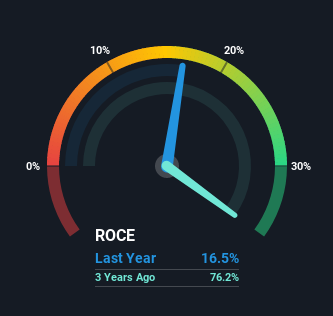- United Kingdom
- /
- Specialty Stores
- /
- LSE:MOTR
Motorpoint Group (LON:MOTR) Might Be Having Difficulty Using Its Capital Effectively
If we want to find a stock that could multiply over the long term, what are the underlying trends we should look for? Ideally, a business will show two trends; firstly a growing return on capital employed (ROCE) and secondly, an increasing amount of capital employed. If you see this, it typically means it's a company with a great business model and plenty of profitable reinvestment opportunities. Having said that, from a first glance at Motorpoint Group (LON:MOTR) we aren't jumping out of our chairs at how returns are trending, but let's have a deeper look.
Understanding Return On Capital Employed (ROCE)
If you haven't worked with ROCE before, it measures the 'return' (pre-tax profit) a company generates from capital employed in its business. The formula for this calculation on Motorpoint Group is:
Return on Capital Employed = Earnings Before Interest and Tax (EBIT) ÷ (Total Assets - Current Liabilities)
0.16 = UK£13m ÷ (UK£205m - UK£128m) (Based on the trailing twelve months to March 2021).
So, Motorpoint Group has an ROCE of 16%. On its own, that's a standard return, however it's much better than the 13% generated by the Specialty Retail industry.
View our latest analysis for Motorpoint Group

Above you can see how the current ROCE for Motorpoint Group compares to its prior returns on capital, but there's only so much you can tell from the past. If you'd like to see what analysts are forecasting going forward, you should check out our free report for Motorpoint Group.
How Are Returns Trending?
In terms of Motorpoint Group's historical ROCE movements, the trend isn't fantastic. Around five years ago the returns on capital were 54%, but since then they've fallen to 16%. Given the business is employing more capital while revenue has slipped, this is a bit concerning. If this were to continue, you might be looking at a company that is trying to reinvest for growth but is actually losing market share since sales haven't increased.
On a separate but related note, it's important to know that Motorpoint Group has a current liabilities to total assets ratio of 63%, which we'd consider pretty high. This effectively means that suppliers (or short-term creditors) are funding a large portion of the business, so just be aware that this can introduce some elements of risk. Ideally we'd like to see this reduce as that would mean fewer obligations bearing risks.
In Conclusion...
From the above analysis, we find it rather worrisome that returns on capital and sales for Motorpoint Group have fallen, meanwhile the business is employing more capital than it was five years ago. But investors must be expecting an improvement of sorts because over the last five yearsthe stock has delivered a respectable 100% return. In any case, the current underlying trends don't bode well for long term performance so unless they reverse, we'd start looking elsewhere.
One final note, you should learn about the 2 warning signs we've spotted with Motorpoint Group (including 1 which makes us a bit uncomfortable) .
While Motorpoint Group may not currently earn the highest returns, we've compiled a list of companies that currently earn more than 25% return on equity. Check out this free list here.
When trading Motorpoint Group or any other investment, use the platform considered by many to be the Professional's Gateway to the Worlds Market, Interactive Brokers. You get the lowest-cost* trading on stocks, options, futures, forex, bonds and funds worldwide from a single integrated account. Promoted
New: Manage All Your Stock Portfolios in One Place
We've created the ultimate portfolio companion for stock investors, and it's free.
• Connect an unlimited number of Portfolios and see your total in one currency
• Be alerted to new Warning Signs or Risks via email or mobile
• Track the Fair Value of your stocks
This article by Simply Wall St is general in nature. We provide commentary based on historical data and analyst forecasts only using an unbiased methodology and our articles are not intended to be financial advice. It does not constitute a recommendation to buy or sell any stock, and does not take account of your objectives, or your financial situation. We aim to bring you long-term focused analysis driven by fundamental data. Note that our analysis may not factor in the latest price-sensitive company announcements or qualitative material. Simply Wall St has no position in any stocks mentioned.
*Interactive Brokers Rated Lowest Cost Broker by StockBrokers.com Annual Online Review 2020
Have feedback on this article? Concerned about the content? Get in touch with us directly. Alternatively, email editorial-team (at) simplywallst.com.
About LSE:MOTR
Motorpoint Group
Operates as an omnichannel vehicle retailer in the United Kingdom.
High growth potential with mediocre balance sheet.
Market Insights
Community Narratives




